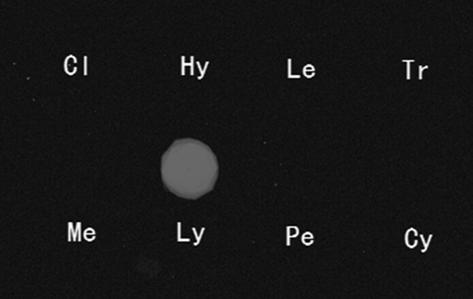Molecular marker, primers and probes for identification of lotus leaf pleura
A technology of lotus leaf lily mushrooms and molecular markers, applied in the field of biological identification, can solve the problems of unreliable identification of bacterial species and difficulties in taxonomy
- Summary
- Abstract
- Description
- Claims
- Application Information
AI Technical Summary
Problems solved by technology
Method used
Image
Examples
Embodiment 1
[0033] Example 1: Extraction of Genomic DNA from the lotus leaf mushroom.
[0034] The sample material of Heyeliphyme fungus was collected from the deciduous broad-leaved forest belt of Guancen Mountain in Kelan area, Xinzhou, Shanxi Province. Lyophyllum decays (Fr.) Singer).
[0035] Using the tissue separation method, the whole fruit body was wiped and disinfected with 75% ethanol, and small pieces of tissue were cut from the cap, stipe, gills, and root with a scalpel, and the excised tissue was soaked in 75% ethanol for 30 seconds. Rinse them with sterile water, and inoculate them in PDA medium (200 g of potatoes, 20 g of glucose, 15 g of agar, and 1 L of water) sterilized at 121° C. for 30 min. The inoculated culture medium was placed in a constant temperature incubator at 27°C, and the growth of mycelia was checked every 24 hours.
[0036] After 8 days of culture, the hyphae were collected, and the total DNA of the fungi was extracted with the SIGMA Fungal Genome Extra...
Embodiment 2
[0037] Example 2: Determination of ITS-specific molecular markers.
[0038] Using the total DNA of the chrysanthemum chrysanthemum obtained in Example 1 as a template, the DNA was amplified by PCR using the universal primers ITS1 / ITS4, and the PCR product was subjected to capillary sequencing to obtain detailed sequence information.
[0039] The sequencing results were compared and analyzed in the whole nucleic acid database in NCBI, and fragments with high conservation were obtained by screening, the results of different selected sequences were compared and selected, and finally a characteristic sequence in the sequencing results was determined, the lotus leaf The amino acid sequence of the specific gene fragment of Shimejime is shown in SEQ ID NO.1.
[0040] After the homology comparison search, it is determined that the selected target sequence is a DNA sequence with high specificity, which can be used as the target sequence for gene chip detection.
Embodiment 3
[0041] Example 3: Design of primers and nucleic acid probes.
[0042] According to the target sequence determined in Example 2 as a molecular marker, according to the primer and nucleic acid probe design principles, design the special primers shown in SEQ ID NO.2 and SEQ ID NO.3, and the nucleic acid probe shown in SEQ ID NO.4 Needle.
[0043] Primer 1: 5'Hex-ATGTCTTTACATACCCCATATG-3'.
[0044] Primer 2: 5'-CAAAAGTAAAGAAGTTGTCCTTA-3'.
[0045] Nucleic acid probe: 5'NH 3 -TTTTTTTTTTTTCAACCCCCACATCCAAACCTAACCAAAC-3'.
[0046] Wherein, the 5' end of the primer 1 is labeled with a fluorescent reporter group Hex; the 5' end of the nucleic acid probe is connected with an amino group, and the nucleic acid probe is subjected to amination treatment.
PUM
 Login to View More
Login to View More Abstract
Description
Claims
Application Information
 Login to View More
Login to View More - R&D
- Intellectual Property
- Life Sciences
- Materials
- Tech Scout
- Unparalleled Data Quality
- Higher Quality Content
- 60% Fewer Hallucinations
Browse by: Latest US Patents, China's latest patents, Technical Efficacy Thesaurus, Application Domain, Technology Topic, Popular Technical Reports.
© 2025 PatSnap. All rights reserved.Legal|Privacy policy|Modern Slavery Act Transparency Statement|Sitemap|About US| Contact US: help@patsnap.com


